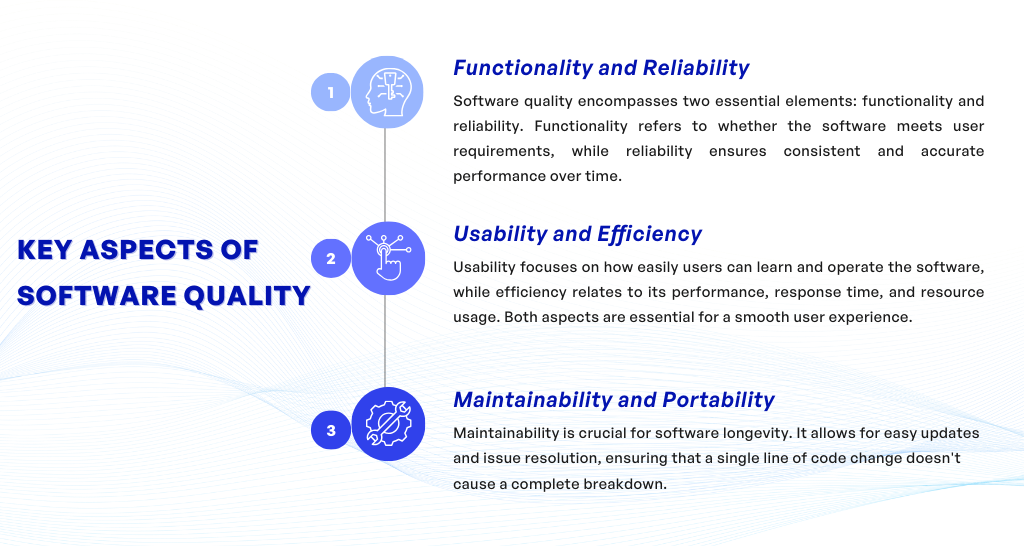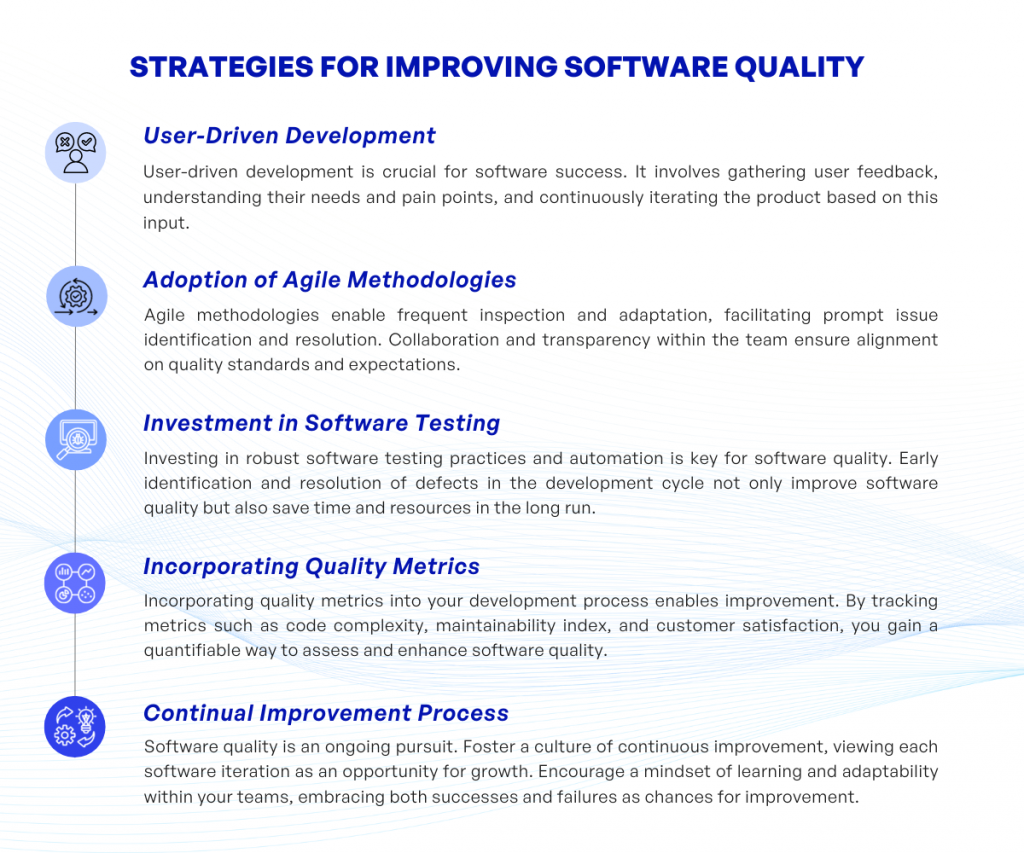
Did you know that maintaining software quality is not merely a nice-to-have but an essential part of successful businesses today? According to a report from the Consortium for IT Software Quality,
Improving software quality can prevent nearly half of system outages which can translate into millions of dollars saved for businesses.
Surprising, right? Whether you are a technical whiz or not, understanding software quality is crucial for the health and success of your business. But don’t worry if it seems like an insurmountable task. In this article, I will provide you with the necessary tools and understanding to navigate this issue effectively.
Keep reading to boost your insights into what software quality is all about, and how you can leverage these insights to optimize the quality of your software products.
1. Understanding Software Quality
Ever wondered what distinguishes a standout piece of software from an average one? The answer lies within a concept known as software quality. But what exactly does this mean in the of a non-technical founder attempting to navigate the complex world of software development?
Software quality might sound like a technical term loaded with jargon but let’s break it down. In simple terms, software quality is the measure of how well a software product or system fulfills a set of defined requirements. These requirements can range from the capability to deliver specific functions, to levels of performance, reliability, and usability. Essentially, software of high quality doesn’t just accomplish what it’s designed to do but does it well.
Think about it this way. You may use numerous software applications in a day – perhaps a browser to navigate the web, an email client to handle your correspondence, or an application to manage your tasks. Have you ever considered why you prefer one over the other, even when they serve the same purpose? It’s because some of these applications promise and deliver a better experience than their competition. That, my friends, is software quality in action!
Understanding software quality is like grasping the criteria for a cooking contest. It’s not just about whether the dish tastes good. The presentation, the balance of flavors, and even the creative use of ingredients all play a massive part in the judges’ final evaluation. Similarly, a high-quality software product isn’t just about its function – it’s about the entire user experience, from performance to aesthetics and beyond.
Now, why should you, as a non-technical founder, care about software quality? It’s simple. Superior software quality directly translates to superior user satisfaction. It’s the differentiator that can help your software product stand above the crowd, generating positive user feedback, increased retention, and ultimately, business success.
The journey towards understanding software quality brings us to areas such as functional and non-functional requirements, key aspects of quality, and components influencing it. Ready to explore further? Let’s dive right in.
2. Functional Requirements vs Non-functional Requirements
While embarking on your software development journey, you will invariably come across two key terms: functional requirements and non-functional requirements. But what do they mean, and how do they influence the overall quality of your software? Let’s break it down in simple terms.
2.1. What are Functional Requirements?
Functional requirements are the meat and potatoes of your software. They encompass what you expect the software to do. These are the specific behaviors or functions of the system. For example, a functional requirement for an e-commerce website might be that it “should be able to process credit card payments”.
2.2. And Non-functional Requirements?
Non-functional requirements, on the other hand, represent how the system behaves while performing these functions. They define the performance characteristics of your software, such as how fast a page should load, the user interface design, or the level of security required. In essence, non-functional requirements are concerned with how well the software does what it’s supposed to do.
With this understanding, you might ask: “Great, but how do these requirements affect the quality of my software?” Good question!
Think of functional requirements as the foundation of your software. Without them, your software would not have any meaningful value – it would be a car without an engine. Non-functional requirements, though not as immediately visible, are equally critical. They are like the polish and tune-up that make a car perform better and provide a smoother ride. In other words, functional requirements get your car moving, while non-functional requirements dictate how pleasant the ride is.
Therefore, a solid understanding of both functional and non-functional requirements is key to driving the quality of your software, resulting in a product that is not only operational but also user-friendly and performance-optimized.
3. Key Aspects of Software Quality

3.1. Functionality and Reliability
One of the key aspects of software quality is functionality. This refers to whether or not the software does what it’s supposed to do. Does it meet the requirements set out by its users? But functionality isn’t enough on its own.
Reliability plays a crucial role too. This means, that once the software performs a task, it should continue to do so consistently and accurately over time.
3.2. Usability and Efficiency
How easy is it for users to learn and operate the software? That’s where usability comes in. It’s an essential aspect of software quality that often gets overlooked. Ideally, users should be able to navigate the application smoothly, without needing extensive technical knowledge.
Efficiency is the next element to consider. This refers to the software’s performance – its response time, speed, and resource usage. Users have little patience for slow, laggy software, making efficiency crucial for a good user experience.
3.3. Maintainability and Portability
You might think that once software is built, that’s the end of the road. But what happens when updates are necessary or problems arise? This is where maintainability comes in. Good software should be easy to adjust and correct. This ensures that the software won’t break down entirely whenever a single line of code needs changing.
Lastly, there is portability. This is another aspect of software quality that is often overlooked. It refers to how easily the software can be transferred from one environment to another. Can you move it from a Windows server to a Linux one? How about from an older operating system to a newer one?
Achieving high software quality is about striking a balance between all these key aspects – functionality, reliability, usability, efficiency, maintainability, and portability.
4. The Role of Software QA in Ensuring Quality
Now that we’ve discussed what software quality entails, you’re probably wondering, “How is such quality assured?” Well, this is where the all-important Software Quality Assurance (QA) comes in, shedding light on our next key topic.
QA aims to prevent errors and defects from occurring in the first place. With it, software development isn’t just about making the code work- it’s about making sure it works right, consistently, and effectively.
QA involves two main spheres: Validation and Verification.
- Verification: This is the process of checking that a product system meets specified requirements. It’s like asking, “Are we building the product right?”
- Validation: This is the process of evaluating a system during or at the end of the development process to determine whether it satisfies the user requirements. It answers the question, “Are we building the right product?”
Surely you’re curious about what this QA process looks like in practice, right? A typical QA process involves a series of steps:
- Requirement Analysis: At the outset, the QA team studies the requirements for a piece of software—what it’s supposed to do and how it’s supposed to do it.
- Planning: Here, the QA team decides on the strategies and tools they will use to ensure quality.
- Testing: The team tests the software, looking for bugs and errors.
- Reporting: Any issues that arise from testing are logged and reported.
- Retesting: After the development team fixes the issues, the QA team tests the software again to ensure the problems have truly been solved.
Through rigorous QA processes, potential errors are identified and fixed before the software even reaches you, ensuring a much higher level of quality than could be achieved otherwise. So, while you may not see it, QA plays a pivotal role in the software that you use. As a founder, it’s important to understand that while it’s not always visible, QA is a cornerstone of software quality.
5. Influences on Software Quality
So what influences software quality? Several factors both internal and external to the software development process can greatly impact the overall quality of the software product. Let’s explore some of them.

5.1. Requirement Specification
Software quality begins with the clarity and completeness of the requirement specification. An incomplete or ambiguous understanding of client requirements can lead to a product that fails to meet the users’ needs. How well are the required features and functionality described? How accurately are these requirements implemented during the development phase? You might want to answer these questions to determine software quality.
5.2. Development Methodology
The development methodology used can also play a significant role in determining software quality. Agile methodologies, for instance, emphasize continuous delivery of high-quality, working software and prioritize user feedback, thus often resulting in superior product quality compared to traditional waterfall methodologies.
5.3. Coding Best Practices
The way developers structure and write their code also has a considerable impact on software quality. Adhering to coding best practices and conventions, regularly conducting code reviews, and ensuring code readability can all contribute to creating more reliable and maintainable software.
5.4. Testing
Effective testing procedures are key to software quality. Testing should be comprehensive, covering all probable scenarios. It not only includes functional testing but also performance testing, security testing, and user experience testing. Rigorous testing uncovers hidden bugs and ensures they are fixed before the software is deployed.
5.5. Infrastructure
Lastly, the environment in which the software is built, deployed, and maintained referred to as infrastructure affects its quality. Factors like server performance, network capacity, and selection of database can impact the performance and scalability of the software.
Remember, excellence in software quality doesn’t just happen; it’s a result of careful planning, competent execution, and continuous monitoring and improvement. By paying attention to these influences on software quality, you can create a product that not only meets but exceeds user expectations.
So, now that we have identified the factors that influence software quality, how do we go about maintaining and enhancing it? In the next section, we’ll dive into strategies designed to improve software quality. Stay tuned!
6. Strategies for Improving Software Quality
We’ve talked about the importance of software quality and the factors that influence it, but how can you, as a non-technical founder, actively work towards improving it in your product? Here are some effective strategies you can adopt.

6.1. User-Driven Development
First and foremost, your software should be developed with the user in mind. This is called user-driven development. It involves gathering feedback from users, understanding their needs and pain points, and constantly iterating your product based on this feedback.
6.2. Adoption of Agile Methodologies
Adopting Agile methodologies can greatly help enhance software quality. Agile promotes frequent inspection and adaptation, which allows teams to identify and correct issues quickly. It emphasizes collaboration and transparency, which ensures everyone on the team is on the same page regarding quality standards and expectations.
6.3. Investment in Software Testing
Remember the age-old adage, “Prevention is better than cure?” It applies to software quality as well. By investing in robust software testing practices and testing automation, you can ensure that defects are identified and fixed early in the development cycle. This not only improves the quality of your software but also helps save time and resources in the long run.
6.4. Incorporating Quality Metrics
Whatever you can measure, you can improve. By incorporating quality metrics into your development process, you can track not just the number of defects, but also metrics like code complexity, maintainability index, and customer satisfaction. This provides a clear and quantifiable way to assess and improve software quality.
6.5. Continual Improvement Process
The pursuit of software quality is a never-ending process. Develop a culture of continuous improvement where each iteration of your software is seen as a chance to improve. Encourage a mindset of learning and adaptability among your teams, where both successes and failures are seen as opportunities for growth and improvement.
In conclusion, improving software quality is not a one-time task, but a continual process that requires strategic planning, user-focused development, effective testing, and a culture of continuous improvement. By implementing these strategies, you, as a non-technical founder, can significantly contribute to enhancing the quality of your software product and ultimately, your customer’s experience.
7. Conclusion
In wrapping up, comprehending software quality is an indispensable part of a non-technical founder’s journey. High-quality software is not a result, but rather, it’s a continuous process that involves various aspects such as functionality, reliability, usability, efficiency, maintainability, and portability. The role of software QA is irrefutable in ensuring these components remain intact.
Moreover, several factors influence software quality, including the requirement specification, the development methodology, the adherence to coding best practices, the approach to testing, and the infrastructure in place. Understanding these factors can provide a clear roadmap on how to build software with superior quality.
There are also numerous strategies you can adopt to improve software quality. These include user-driven development that places your audience at the center, agile methodologies for flexibility, investment in sophisticated software testing, incorporation of quality metrics for measurement, and a commitment to continual improvement.
To put it simply, software quality is not a destination. It’s a journey that requires consistent effort, attention, and improvements. It translates to user satisfaction, improved reliability, decreased maintenance costs, and higher revenue. Embrace it, invest in it, and watch your business thrive.
Remember, good software isn’t just about code—it’s about thinking ahead, anticipating the potential, and ensuring every step in the process aims for quality.
If you have any questions regarding quality software, feel free to contact KVY TECH.


